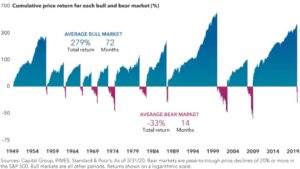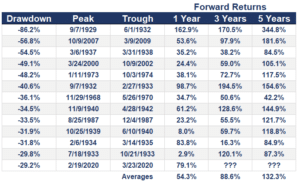The U.S. stock market is down around 23% from its highs as I’m writing this, which means we’re officially in a bear market. As is to be expected during scary stock market downswings, I’m getting a lot of questions along the lines of:
“Is it still a good time to invest my money in the stock market?”
My short answer would be yes, it’s still a very good time to invest in the stock market, especially if you have a long time horizon. Let me use some numbers and historical data to explain why.

While bear markets are frightening because they’re typically accompanied by bad economic news which seems like it will go on forever, the opposite has actually been true. Bear markets tend to be rather short-lived compared to the amount of time stock prices rise.
If I had to choose one chart to show people who are nervous about the stock market right now, I think it would be this one:

Going back to 1949, the average bear market lasted 14 months with a total return of -33% while the average bull market lasted 72 months with a total return of 279%.
We’re currently in one of those bear markets right now that is shown in red. As you can see, trying to pinpoint the exact time the market is done falling before you invest your money is pointless. The short periods of losses will all be swept up in the huge market gains that have always followed bear markets.

Not only is investing during bear markets a good time to invest, it’s usually one of the best times. Buying stocks on sale tends to be a winning strategy over the long run. Even if the market drops further, buying stocks after they have already fallen 20% has led to nice returns historically.
Look at these positive returns following past bear markets:

The average 1-year return from the bottom of a bear market is nearly 55% and the average 5-year return is 132%!
Market drawdowns are no fun, but the good news is the expected returns to simply break even are pretty good. It’s just math. The bigger the loss, the bigger the gain needed to make it back.
The last three bear markets have all been relatively short-lived. Eight out of the 15 bear markets broke even in less than a year. The worst-case scenarios were the 1973-1974, 2000-2002, and 2007-2009 crashes which all took more than four years to recover.
As I stated above, the U.S. stock market is down 23% from all-time highs. If we hit the average bear market and end up down 33%, that would require about a 50% gain to break even.
If you expect the market will take two years to bounce back, that would mean a 22% gain per year. Over 3 years it would be 14% annualized. Even if it took four years, that’s still 11% returns per year. Not too shabby, right?
The bigger the market drop, the higher the expected future returns.
So, if we assume that the market will recover within the next few years, future returns are looking quite attractive right now.
Of course, maybe this assumption isn’t true. But if it is true, then every additional decline from here on out is another buying opportunity. Another chance to take advantage of temporarily depressed prices.

Now, I know I just went through a lot of numbers when in reality dealing with market downturns has more to do with emotions than anything else.
There may be some who are thinking to themselves, “That data is all well and good, but this time it’s different because there’s a war happening, bonds are also getting crushed, inflation isn’t slowing down, home prices are skyrocketing, wages aren’t keeping up, and the Fed keeps raising interest rates.”
All of that is true. But remember that all of those bear markets in the past happened for a reason. Bad stuff was happening then too. People were pessimistic then too. Things always seem doom and gloom until they don’t and the market makes a recovery.
Who knows how bad this could get or how long it will last, but bear markets provide a great opportunity for long-term investors looking to achieve high returns over time.
Thanks for reading!

